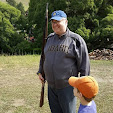Before I get too far into reviewing the different poses, I want to write about the command figures and the shield transfers.
Each of the three units gets an optio, a centurion, a cornicen, and a signifer. The signifer gets a choice of two standards: totem (seen here) or eagle. The centurion and optio can get either a vine stick or gladius. I chose to give all my centurions vine sticks and optios swords, but you could certainly mix it up. My only real disappointment with the command figures was the wolfskin on the signifer and cornicen. The hair just didn't have enough relief to take a drybrush very well, and the result is a very flat looking wolfskin.
The shield transfers, designed by Stephen Hales of Little Big Men Studios, are very attractive. Unlike his waterslide transfers, they're completely opaque, so you don't have to paint the shield white before using them. I primed the shields black, drybrushed silver on the bosses, painted the backs brown, and rubbed the transfers on.
The rub-on process was very tough to get the hang of. I tried keeping the transfer right on the sheet, but I could never get it to line up correctly with the shield boss and spine. I settled on a very laborious process, cutting a hole for the spine and boss with a hobby knife, then cutting the entire transfer off the sheet with a pair of scissors. It took me three hours to complete this process for all 45 shields.
My next step was to paint the shield spine a dark red and pick out the spine itself with a straight red. Then I glued the shields to the painted figures and painted the sides of the shields red. I tried to match the color of the transfer, but I just couldn't do it. Each transfer is slightly different, as Stephen gave the shields a realistic weathered result. Unfortunately, that means that the 36 different transfers are 36 different shades of red.
Now, back to the figures. This is the first unit, and it's the unit that required the most work to construct. I cut the plumes off each of these helmets, and I cut the gladius handle off of each torso. All the completed figures in this review are mounted on 60mm x 20mm Litko bases, four figures to a stand. That's the Field of Glory standard for heavy infantry.
Unfortunately, that's not enough depth for these figures, and you can see why from this photo. Those shields stick out in front of the bases, sometimes quite a bit. I tried those shield arms in various positions, but nothing could keep them from projecting too far in front. That's not a problem in a single rank (although it will be when they contact the enemy), but it's a huge problem when forming a supported line.
Still, the figures paint up well. Here are a few closeups:


 You can see that I mixed up the gladius arm a bit, using some stabbing and some just holding them aloft. The stabbing arms were a good idea, but porrly executed, as the legionaries just end up stabbing into their shields.
You can see that I mixed up the gladius arm a bit, using some stabbing and some just holding them aloft. The stabbing arms were a good idea, but porrly executed, as the legionaries just end up stabbing into their shields.So again, in a single line, this looks like a great unit. But I have a few Field of Glory games under my belt, and I know that most units will fight in double line. Here's the best I could do with a double line:

They just don't rank up. You can see from this top view how many different hand positions I tried. The second ranker on the far right comes the closest to fitting, but even he can't quite make it. I mentioned it before, but the seperate arms really should be part of the torso. This would let the legionaries bend their elbows and keep the shields close to their bodies.
For the next two poses, I'll keep the commentary short and mostly let the pictures speak for themselves.
Part III: Advancing with Pila













Thank you sooo much for showing how these figures base up. It's disapointing that the 'official' FoG 25mms will not base up properly for FoG's odd basing system for 25mms.
ReplyDeleteIsn't the 60x20mm Base dimension the standard "Legacy" WRG base size? Most of my old (metal) 25mm Figures are already based to this standard.
ReplyDelete